Green infrastructure: design and placemaking
Report on design and placemaking in the green infrastructure.
Part 1: About Green Infrastructure ( GI)
What?
Description
The European Commission defines green infrastructure as "the use of ecosystems, green spaces and water in strategic land use planning to deliver environmental and quality of life benefits. It includes parks, open spaces, playing fields, woodlands, wetlands, road verges, allotments and private gardens. Green infrastructure can contribute to climate change mitigation and adaptation, natural disaster risk mitigation, protection against flooding and erosion as well as biodiversity conservation."
So green infrastructure is not just about greenspaces like parks and open spaces, it also incorporates blue infrastructure including sustainable urban drainage, swales, wetlands, rivers and canals and their banks, and other water courses. The figure below seeks to demystify 'green infrastructure' by setting out in basic terms examples of individual components of green infrastructure, at different scales.
Considering green spaces or connections as infrastructure arises because simple things like trees, greenspaces and watercourses can provide valuable services in an ecological way. Green infrastructure can deliver on functions and services such as shelter, access and travel, sustainable urban drainage, pollution mitigation and food production - as part of a wider ecosystem. Moreover this approach has the added benefit of enhancing habitats and creating attractive places. This multifunctional nature of green infrastructure is one of its intrinsic benefits and can operate at differing levels.
Individual elements of green infrastructure can serve a useful green infrastructure purpose, without being connected. However, when green infrastructure components are linked together to form green networks further combined benefits can be achieved at a strategic level.

Range of scales
Green infrastructure should be thought about at every scale of planning, from the strategic framework (allowing cross boundary issues to be considered) right down through neighbourhoods and within streets to the individual house or flat.
Below are examples of how green infrastructure can be incorporated at each scale to make connections and movement easier.
The building
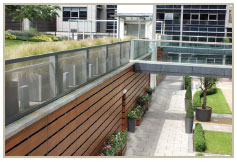
Green roof systems are now widespread across Europe. Green roofs (also known as vegetated roofs, or living roofs) are systems that are essentially roofs with vegetation placed upon them in a way to provide benefits. Similar construction techniques can be applied to wall surfaces to create living walls with similar benefits.
Green roofs can provide and connect habitats for birds and insects, creating ecological corridors.
Increasing the amount of vegetation can help absorb rainfall and mitigate against flooding, and so be seen as a climate change adaptation technique.
Rooftop surfaces cover a significant proportion of surface area in the built environment, but have been underutilised as functional space. They can be utilised as outdoor living spaces, terraces, roof gardens and on larger scales even allotments and parks - providing areas for escape and relaxation.
Street level
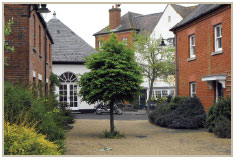
Green infrastructure can play a role in making streets pedestrian, cycle and vehicle-friendly.
Designing Streets encourages intelligent and appropriate planting in street design.
For example street trees can be incorporated as a traffic calming measure which also help soften the street scene by creating visual interest, improving the microclimate and providing valuable wildlife habitats.
Vegetation can be used to limit traffic speeds by limiting excessive forward visibility, whilst appropriate driver sightlines should be maintained.
Neighbourhood level
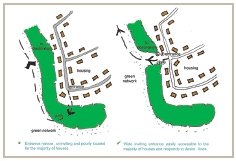
At the neighbourhood level it is important to think about how the scheme will integrate with existing roads, paths and surrounding development.
This means creating opportunities for easy access into the green network including accessible entrances in the right places and suitable paths. It also means avoiding ill siting of buildings which could block the best place for accessing the green network, the obvious desire lines.
Making it easy to access will encourage residents and workers to use the green network for short journeys rather than using cars, helping reduce emissions and promoting active lifestyles.
South Lanarkshire Green Network Quality Design Guide, 2009
Strategic level

© Sheppard and Robson
Development plans and masterplans should knit developments into the wider green network.
Thinking about how development can join up to the existing green network not only provides opportunities to plug gaps in the strategic green network and landscape setting, it also offers benefits to the new development by providing good connections and a continuous network of routes.
Looking beyond the immediate boundary or site ownership is vital - allowing the bigger picture to emerge, and to think about how best to connect to the wider network.
Scottish Placemaking Case Study - Clyde Gateway
Simple shifts from grey to green
Making the change from grey to green can be easier than you think and can achieve transformational change through practical measures for example:
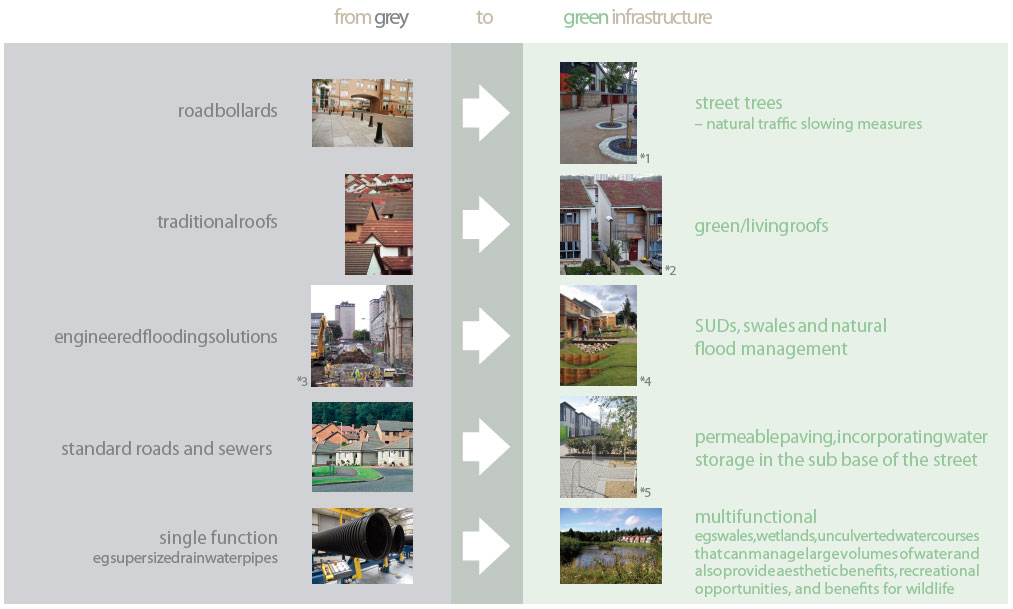
*Photo credits 1: EDAW, 2: Greenroof UK Ltd, 3 & 6 The Metropolitan Glasgow Strategic Drainage Partnership, 4: Cadell2, 5: PARC Craigmillar
Why?
Benefits
| Placemaking |
|
|---|---|
| Economic |
|
| Climate change |
|
| Environmental |
|
| Community and social |
|
| Health and Well-being |
|
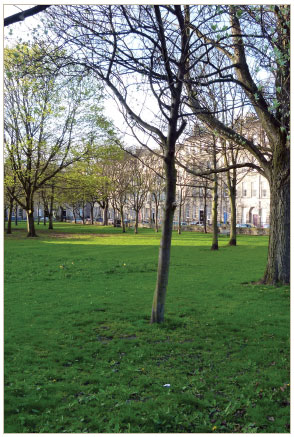
Green Infrastructure Valuation Toolkit
Green Infrastructure North West
Benefits of Green Infrastructure
(Forest Research)
Who?
Should think about green infrastructure?
Everyone can play their part in delivering green infrastructure. From householders looking to retro-fit their home, with elements of green infrastructure such as a roof garden, to community groups getting together to set up community gardens or allotments, through to housebuilders designing new sites, or infrastructure and service providers looking at ways to deal with flooding, green infrastructure can strike a chord with each.
Green infrastructure thinking spans the public sector (local authorities, government agencies), the private sector (landowners, developers), the third sector and communities.
Local authorities and developers should consider green infrastructure when considering masterplans and ensure necessary consultants are in place to marry design proposals with surface water management strategies and habitat networks ( egstrategic drainage engineers, ecologists, landscape architects).
Should work together?
A collaborative multi-disciplinary approach offers great benefits in developing an integrated solution that will work on the ground, drawing upon different specialisms and areas of expertise, on a partnership basis.
Equally important is seeking input from local communities to tap into their local knowledge and give them a chance to shape the design. Communities can offer useful input of what existing green infrastructure should be kept, the best places for new connections, routes and linkages, and what new additions they would like in their area, be it allotments, cycle routes, parks or wildlife havens. This can help foster community pride in the place.
There are various green network partnerships operating across Scotland which can offer valuable support.
Can offer help and advice?
A great deal of support on green infrastructure is available. As well as local authorities and strategic planning authorities, other national and regional organisations and bodies can offer help and advice.
Financial support is available from the CSGN Development Fund which is intended to support the development and implementation of early projects delivering the Green Network on the ground. The Scotland Rural Development Programme is another potential source of support (particularly for urban woodland).
Sharing ideas and best practice amongst practitioners provides opportunity to learn from one another's experience. Case studies are available online from the Scottish Government, Greenspace Scotland, Central Scotland Green Network and local bodies like Glasgow and Clyde Valley Green Network Partnership.


When?
Policy Framework
Development plans and supplementary guidance should set the context upfront to support green infrastructure thinking at the design and masterplan level.
Green infrastructure can deliver on a range of good policy outcomes, for placemaking, health, sustainable transport, landscape, tackling flooding, climate change, sustainable flood management, biodiversity and economic growth. GI can be thought of as a green thread weaving through the tiers of policy and advice, bringing these ideas together in a holistic way.
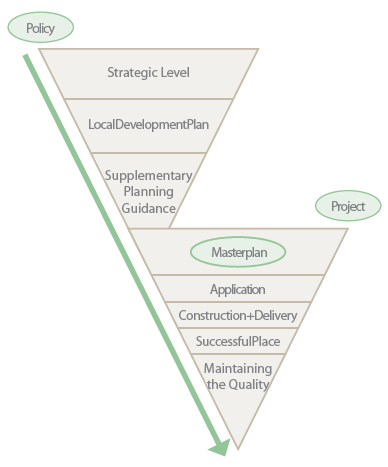
Development Planning
Strategic Development Plan
- Sets out strategic context
- Identifies key strategic projects/key areas to form part of larger networks
- Supports effective cross boundary and partnership working
- Embeds wider concept of green infrastructure and networks
- Provides for strategic routes for active travel
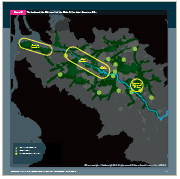
Local Development Plan
- Sets out the spatial strategy - detailed locations of the green network
- May set out a hierarchy of spaces in the green network
- May identify areas where actions could strengthen the green network or links enhanced
- Policies support incorporation of green infrastructure in the design of new places
- May set development aspirations
- Promotes a masterplanning approach
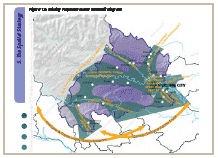
Supplementary Planning Guidance
- Sets out design principles for place-making
- May set out ways in which green infrastructure can be included in the design of new places
- May provide a guide to the delivery of high quality, well managed green network with accessible open space
- May provide guidance or a framework for assessing planning applications
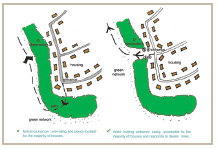
Masterplan
- Designing individual spaces for multifunctional benefits
- Designing sustainable and attractive places and communities served with green infrastructure
- Identifying likely management costs at the outset and designing solutions to suit the budget
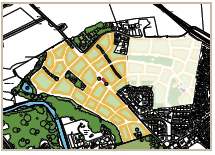
Green Infrastructure can happen at all stages of policy making and planning
Masterplan / Project
Green infrastructure principles should be embedded from the start; site appraisal through to the design stages in developing masterplans.
Planning the structure of planting and prioritising green infrastructure is a good and ecologically sound way to inform and underpin the overall design of a site or proposal. It should be thought about from the beginning rather than being something extra that has to be provided separately through developer contributions/obligations.
Developers of major developments are required to carry out pre-application consultation with the community before they submit their planning application. Green infrastructure is a relevant issue to be discussed in these pre-application consultations with the community who can offer local knowledge. It should also feature in pre-application discussions with the local authority and key agencies to help shape the masterplan at an early stage.

Temporary Greening
Stalled sites have become more common around the country, as the economic slowdown has resulted in development proposals often taking longer to get off the ground. If they become derelict, these stalled sites have potential to have a negative impact on local neighbourhoods, affecting the place's appearance and image. Temporary greening may be an appropriate way to create safe and attractive places until development can come back on stream. Issues around site ownership and managing community expectations should be discussed to determine whether temporary greening is appropriate in individual cases.
Stalled Spaces, Report, Greenspace Scotland
Advance Greening
Green features on site can be kept and new structural planting put in in advance of construction. This can ensure essential green infrastructure, trees and other planting can become established, mature and resilient before the full development is completed, creating an attractive landscape framework.
Advanced greening need not be expensive within the overall budget of a development. But it can address neighbour issues, benefit the perception of the project and aid marketing of the site.
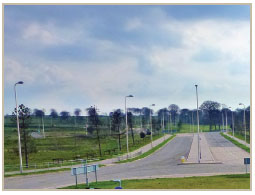
Advance planting at Business Park, Heartlands
© Ecosse Regeneration Ltd
Retrofitting
As well as delivering new green networks, the adaptation of existing communities with green infrastructure to cater for the present and future needs of society may be necessary. Climate change, in particular, brings significant issues that could necessitate the remodelling of open space and buildings. Reviews of existing open spaces creates the potential to improve the overall sustainability and performance of places; to make them more resilient to the effects of climate change; to renew tired and single function open space; and to provide for a wider range of uses with multiple benefits for people and wildlife, enhancing the quality of life and overall sustainability performance of communities in the future.
There are also important opportunities to re-establish missing links and to create new linkages to enhance strategic green networks.
There may be significant possibilities for green network promotion within areas of former industrial or brownfield land, or areas proposed for re-development or neighbourhood renewal. At a domestic level retro-fitting greenspaces around housing which have been lost to driveways ( egthrough permeable paving) can help alleviate local flood risks.
An example retrofitting green infrastructure in New York (see section).
There is a problem
Thanks for your feedback